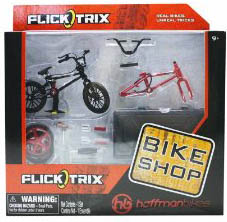Flick Trix
BMX finger bikes
 Flick Trix are authentic mini BMX bikes with real working chains, cranks, and even brakes. You can pull of tail whips, back flips, and other sick tricks like the pros. Coming with custom wheels, these are authentic scale replicas of real bikes. Throw down some tricks. Dial in your ride.
Flick Trix are authentic mini BMX bikes with real working chains, cranks, and even brakes. You can pull of tail whips, back flips, and other sick tricks like the pros. Coming with custom wheels, these are authentic scale replicas of real bikes. Throw down some tricks. Dial in your ride.
History of BMX
The history of BMX (Bicycle Motocross) traces back to the late 1960s and early 1970s, originating from the passion for bicycle racing and the desire to emulate the thrill of motocross racing on two wheels. The progression of BMX can be summarized in key stages:
1960s: Emergence of Motocross Inspiration
The motocross craze of the 1960s inspired young cyclists to imitate the exciting jumps, dirt tracks, and races on bicycles. This sparked the idea of creating a sport that would combine the thrill of motocross with the agility of bicycles.
1970s: The Birth of BMX
In the early 1970s, BMX as a sport gained traction. Children and teenagers began to modify their bicycles for off-road racing and freestyle tricks. This led to the establishment of dedicated tracks and informal competitions in various parts of the United States.
1970s: Pioneering Organizations
In 1974, the Pedalers Bicycle Association (PBA) was formed by Bob Osborn, aiming to promote BMX racing and provide standardized rules for competitions. This marked a pivotal moment in formalizing the sport and encouraging its growth.
1970s: Influence of Skateboarding
The rise of skateboarding culture in the 1970s played a role in shaping BMX's freestyle aspect. Riders began experimenting with tricks and stunts, giving birth to the freestyle BMX discipline. Skate parks became early venues for BMX riders to showcase their skills.
1970s-1980s: Commercialization and Expansion
As the popularity of BMX grew, manufacturers began producing specialized BMX bicycles. The first BMX-specific bike, the "Laguna MX" by Schwinn, was introduced in 1974. The demand for BMX equipment, parts, and gear led to a flourishing industry.
1980s: Global Recognition
The 1980s marked BMX's transition from a niche activity to a globally recognized sport. The American Bicycle Association (ABA) and National Bicycle League (NBL) were established as governing bodies for BMX racing, further legitimizing the sport.
1980s: Freestyle Dominance
The 1980s saw the rise of freestyle BMX, with riders like Mat Hoffman, Dave Mirra, and Dennis McCoy pushing the boundaries of what was possible on a BMX bike. The creation of BMX freestyle competitions and events solidified the discipline's place within the sport.
1990s-Present: Continued Growth
BMX continued to evolve in the 1990s and beyond. The sport gained inclusion in the Summer Olympics, debuting in the 2008 Beijing Games. BMX's influence extended to video games, movies, and pop culture, further contributing to its popularity.
Modern Era: Diverse Disciplines
BMX has diversified into various disciplines, including racing, park, street, dirt, and flatland. Each discipline showcases different riding styles and skills, reflecting the versatility of BMX riders.
Today: Global Community
BMX has a vibrant and diverse community of riders, ranging from amateur enthusiasts to professional athletes. The sport continues to evolve with advancements in bike technology and the ongoing pursuit of pushing boundaries in terms of tricks and creativity.
The history of BMX is characterized by the fusion of motocross inspiration, skateboarding influence, and the passion of cyclists seeking excitement and competition on two wheels. From its grassroots beginnings to its inclusion in major sporting events, BMX has solidified its status as an iconic and dynamic sport beloved by riders and enthusiasts around the world.
